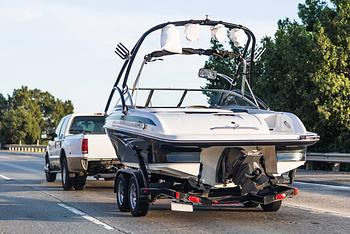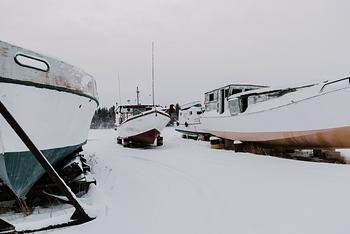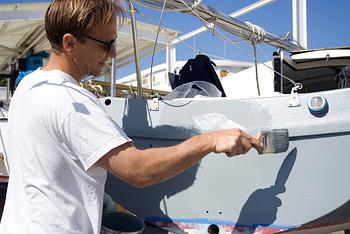The air is getting warmer and the snowmen have melted away. It’s time to get your boat ready for those long summer days on the water. If you followed our guide to preparing your boat for the winter lay-off you’ll know that it takes a little work to get it ready for the summer and to ensure that your Sailing Boat is safe and fun all summer long.
Time and money can be saved by taking a few simple steps of preventative care. Although every boat will have its own unique requirements, by following a few general steps any keen DIYer armed with no more than a few basic tools and materials in one hand and their owner’s manual in the other, can easily save themselves both time and money. In this guide, we’ll look at a few of the basic measures you can take to ensure that your boat is in tip-top shape to take to the open water. Whilst not exhaustive, we’ve covered many of the basic areas you’ll need to check. Remember, if in any doubt, consult a professional.
Hull
- Visually inspect the hull(Check out Monohull Boats and Multihull Boats).
- Check any canvas covers/tarps for rips or damage and clean with a mild detergent.
- Ensure all screws and fittings are tight and lubricated.
- Examine the hull for cracks, scratches, abrasions, gouges or damage and repair if needed. Refinish any blisters on the hull.
- Give the hull a thorough clean using a mild detergent ensuring you remove any dust or mildew that may have collected over the storage period.
- Touch up the antifouling paint if needed.
- Apply a good coat of wax to the hull.
- Clean and polish fittings with a good quality metal polish.
- Clean and oil any teak surfaces.
- Check all hatches and clean.
- Clean the interior including the bilges.
- Check the rudder is free of any obstructions.
- Inspect the swim platform and ladder for damage/wear.
- Test and inspect the trim tabs.
- Check rub rails, shaft, cutlass bearing, strut and prop.
Engines
- Check any exposed fuel hoses for any signs of deterioration or rot. Poor hoses feel too soft and brittle whilst a structurally sound hose will be both pliable and firm when you move them.
- If your fuel system has a primer, as is the case with most outboards, squeeze the hose and carefully look for any signs of leakage.
- Check and change any fuel filters and ensure that you have spares onboard.
- Check and/or replace the spark plugs. Examine the leads for wear and replace if necessary.
- Sacrificial zincs are used in your engine to counteract galvanic corrosion. Check their condition and replace as necessary.
- Check the cooling system and change or top up the coolant as necessary. Ensure you have extra coolant onboard. If you have an inboard engine that was winterised using a standard green antifreeze, drain and dispose of responsibly. Replace with non-toxic blue antifreeze.
- Check and top up the transmission fluid and engine oil.
- Check the movement range of all cables and lubricate or replace if necessary.
- Check any belts for wear or corrosion. Look for any signs of rot and tighten or replace as necessary.
- Check and clean the backfire flame arrester.
- Check the bilge blower.
- Lubricate and spray any movable parts.
- Inspect tank for any leaks.
- Record all the engine maintenance especially the date and hours of the last engine oil change.
- Consider having the engines professionally tuned/serviced at the start of the sailing boat season.
Electrical System
- Charge your battery on a slow charge (3 amps) overnight then let it sit for a day before taking it to a dealer and have it “load tested”. This simulates a battery under normal usage and will give you a realistic picture of the condition. On average, a good quality battery that has been stored and looked after correctly will last around 4-5 years.
- Check the water levels in each cell of the battery and top up if required.
- Check the battery leads for corrosion and lubricate.
- Check the battery harness is intact and holding the battery securely.
- Inspect all the wiring for wear and chafe.
- Check shore power charger.
- Check spare fuses and replace if needed.
- Check all lighting fixtures (including navigation lights) and ensure you have spares for all of them.
- Inspect antennas and aerials.
- Test all gauges operate correctly.
Propeller
- If you didn’t remove the prop during your winter lay-off then grease the shaft and check for obstructions such as fishing boat lines, etc.
Sails
- Check the general condition paying particular attention for wear and chafing.
- Inspect battens and batten pockets.
- Inspect bolt rope.
- Check all sailboat attachments and repair if needed.
Masts/Rigging
- Inspect the mast and spreaders for damage and corrosion.
- Clean the sail track.
- Examine spreader boots and shrouds.
- Ensure there is no corrosion in reefing points and gear.
- Check rigging for wear and corrosion.
- Check turnbuckles and clevis pins for wear and corrosion.
- Check stays for fraying and “fish hooks”.
- Inspect forestay and backstay condition.
- Check masthead fitting and all pulleys.
- Lubricate roller furling.
- Check halyards.
- Tape cotter pins, turnbuckles and spreaders.
Waterpumps
- If you haven’t replaced your waterpump impeller for 3-4 years then now is a good time to consider doing so. Poor performance boat can affect engine cooling and economy.
- Check the blade shape, pliability and wear patterns.
- NEVER fire up your engine without supplying it with water- you’ll burn out your impeller within seconds.
Deck, Fittings, Safety Equipment
- Check the integrity of stanchion, pulpit and lifelines.
- Inspect hull/deck joint.
- Lubricate blocks, pad eyes, etc.
- Inspect and lubricate anchor windlass.
- Check lines, fenders, ground tackle, chainplates and cleats.
- Inspect deck, windows and port lights for signs of leakage.
- Clean and/or replace wiper blades.
Below Deck
- Inspect and test seacocks and lubricate if necessary.
- Ensure hoses and clamps are in serviceable condition. Make sure that all below waterline hoses are double clamped.
- Check the bilge pump operates both automatically and manually. Ensure there is no oil in the bilge.
- Clear any debris from the limber holes.
Water System
- Flush the water tank and check for leaks.
- Ensure hot water tank works on both AC and engines.
- Clean and check shower sump pump screens.
Safety Equipment
- Inspect dinghy.
- Check distress flares’ expiry date.
- Inspect life rings and cushions.
- Check fire extinguisher- recharge if needed. Replace any extinguisher over 5 years old.
- Check and adjust compass.
- Check navigation lights work and re-stock spares.
- Check charts and replace if needed.
- Check radar reflector.
- Check first aid and re-stock if necessary.
- Check the horn.
- Replace any life jackets that show signs of wear. Ensure there are enough for all the passengers you intend to have onboard.
- Check your toolkit for the appropriate tools needed for routine maintenance.
Galley and Head
- Fill propane tank and check electric and manual valves.
- Clean and freshen the fridge and cooker (including burners).
- Check the Y-valve operation on the head.
- Ensure the smooth operation of the head and lubricate if necessary.
- If equipped with a treatment system, top up the chemicals.
Trailer
- Check tyre pressure, grease or repack wheel bearings.
- Check trailer lights and electrical connections.
- Check the coupler is secure.
- Examine for corrosion and water intrusion. Pay particular attention to the brakes.
- Check rollers and pads.
- Check safety chains.
- Clean and lubricate the winch.
And finally and most importantly, before your first trip of the new year, ensure you’ve installed your drain plug!
Related Articles and Guides
29th Mar 2024
How to Transport Your Boat Four Different Ways
There are several ways to ship a boat for you to consider, and the right one will depend on the size and type of...
18th Oct 2023
How to Winterize a Boat: Steps, Checklist and Costs
If freezing temperatures are a possibility, you need to winterize your boat.
20th Sep 2023
Painting a Fiberglass Boat: A Detailed Guide
If you want to keep your boat looking as good as new but it’s in need of a facelift, few things will put on a fr...
19th Sep 2023
Renaming a Boat the Proper Way
If you're buying a boat with a name that doesn't suit you or you find that the name of your current boat no long...






